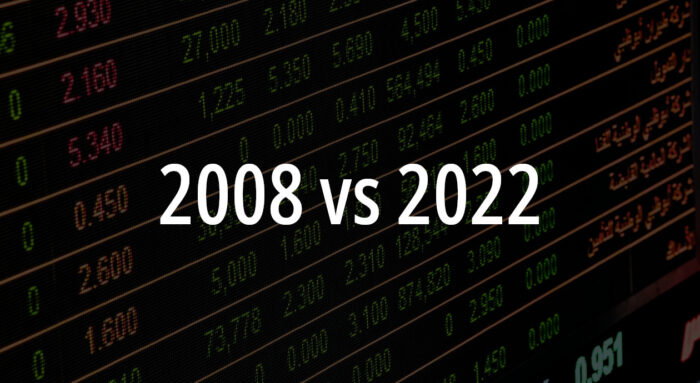อ่านบทความ The Cryptocurrency Crash Is Replaying 2008 as Absurdly as Possible ใน Foreign Policy
ผู้เขียน David Gerard ที่เป็น crypto critique ได้เปรียบเทียบสถานการณ์ของวิกฤตเศรษฐกิจปี 2008 และฟองสบู่คริปโตปี 2022 (?) ไว้ได้อย่างน่าสนใจ
เริ่มจากสถานการณ์เศรษฐกิจช่วงก่อนปี 2008 (อาจเป็นราวปี 2005-2007) ที่ร้อนแรง (เทียบได้กับเศรษฐกิจปี 2021)
In the lead-up to the 2008 financial crisis, the economy was running hot. Companies were making stupendous amounts of money and had to put it somewhere.
พอเศรษฐกิจร้อนแรง เงินเลยมีความต้องการไหลไปเก็บยังสินทรัพย์ที่ “ปลอดภัย” (with quotes)
There was such a huge demand for safe dollar-equivalent assets that supplies of Treasurys and other such superstable assets were running low.
นักการเงินเลยประดิษฐ์สินทรัพย์ทางการเงินใหม่ขึ้นมารับความต้องการนี้
เคสของปี 2008 คือ ผลิตภัณฑ์ทางการเงินแบบใหม่ๆ (เช่น CDS) ที่ค้ำประกันโดยสินทรัพย์บางอย่าง ในกรณีนี้คือ อสังหาริมทรัพย์ (real estate) แต่มันก็ไม่จำเป็นต้องเป็นอสังหาริมทรัพย์โดยตรงเสมอไป เพราะสามารถใช้ “หลักทรัพย์” (security) ที่ค้ำโดยอสังหาริมทรัพย์อีกชั้นก็ได้
Financial engineers synthesized “safe” dollar-equivalent products to meet the demand—backed by assets such as real estate, or by securities backed by real estate, or by bets on securities backed by real estate.
ผลิตภัณฑ์การเงินแบบนี้เวิร์คในยามที่สภาพตลาดดี แต่เมื่อตลาดเข้าสู่ขาลง ทุกอย่างก็พังทลายจนกลายเป็นวิกฤตปี 2007-2008
This worked until the housing market had the slightest downturn, at which point the chain of leveraged bets unwound and threatened to take the wider economy with them.
ผู้เขียนเสนอว่า สถานการณ์ของฟองสบู่คริปโตในปี 2021-2022 ก็เดินตามในลักษณะเดียวกัน นั่นคือ เศรษฐกิจในปี 2021 ยุค post-covid เติบโตร้อนแรงมาก เงินไหลไปยังตลาดคริปโต และคนในแวดวงคริปโตก็สร้าง “ผลิตภัณฑ์การเงิน” ลักษณะคล้ายกันขึ้นมารับความต้องการนี้
สิ่งที่ต่างไปคือ ผลิตภัณฑ์การเงินในยุคก่อน 2008 ยังพอมีสินทรัพย์จริงๆ (อสังหา) ค้ำไว้อยู่บ้าง (แม้คำนวณยากและซับซ้อน) แต่ผลิตภัณฑ์การเงินปี 2022 เป็นการต่อยอดมาจากสินทรัพย์เงินดอลลาร์ล้วนๆ ไม่มีอย่างอื่นปน
ผลิตภัณฑ์ที่ว่านี้คือ stablecoin ซึ่งประดิษฐ์ขึ้นมาเพื่อแก้ปัญหาค่าเงินคริปโตแบบดั้งเดิม (e.g. Bitcoin) เหวี่ยงมากเกินไป (+-10% ในวันเดียว)
Ordinary cryptocurrencies are notoriously volatile—bitcoin regularly goes up or down 10 percent in a day, making speed crucial. So the industry created “stablecoins”: blockchain tokens worth precisely one dollar that can be traded as stable dollar-equivalents at the speed of the blockchain, without the need to wait for banks.
stablecoin ยังมีประโยชน์ (ต่อคนบางกลุ่ม) ในแง่การหลบเลี่ยงการกำกับดูแลต่างๆ ได้สะดวกกว่าการถือเงิน fiat จริงๆ อย่างมาก
stablecoins save their users all that tedious red tape of financial regulation, compliance with anti-money-laundering laws, or being a known and named entity with a bank account.
ประเด็นคือ ตัว stablecoin มีความคล้ายกับพวก CDS ตรงที่การค้ำประกันมูลค่านั้นไม่ได้ตรงไปตรงมา มีความซับซ้อน (complexity of abstraction) หลายชั้น ซึ่งแยกได้เป็น 2 กลุ่มใหญ่ๆ คือ
1) กลุ่มที่ “อ้าง” ว่ามีสินทรัพย์จริงมาค้ำเสมอ (เช่น Tether/USDT) แต่ตรวจสอบไม่ได้ว่ามีจริงๆ อย่างที่อ้างหรือไม่
กรณีของ Tether ใช้วิธีเปิดเผยข้อมูลการยืนยันมูลค่าเป็นช่วงๆ (snapshot) แถมช่วงที่เปิดข้อมูลออกมาก็ยืมเงินจากคนอื่นมาเพื่อให้ดูมูลค่าสินทรัพย์ว่ามีเยอะจริงๆ ก่อนคืนเงินกลับด้วย
Unfortunately, many stablecoins claiming dollar backing have turned out not to be fully backed. None of the reserve-backed stablecoins has ever been properly audited; the issuers present only snapshot attestations, where a single moment’s finances are treated as if they were a permanent supply.
For instance, one of the most prominent stablecoins, iFinex’s tether, borrowed money on the morning of one snapshot attestation to appear backed, before returning the money the next day.
2) กลุ่มที่ใช้ความซับซ้อนทางอัลกอริทึมมาค้ำประกันแทน (เช่น Terra/UST) อันนี้ฟองสบู่แตกไปเรียบร้อยแล้ว
The other way to run a stablecoin is to do an “algorithmic” stablecoin. This backs the supposedly stable dollar tokens with reserves of volatile cryptocurrencies. The issuers claim that an algorithm can maintain a stable price, whatever the reserve does, and keep the stablecoin’s value at one dollar.
ตรงนี้มีอีกประเด็นที่น่าสนใจคือ ในประวัติศาสตร์การเงินเคยมีเรื่องแบบนี้เกิดขึ้นมาก่อนแล้ว (ผมก็เพิ่งทราบ) รายละเอียดอยู่ใน บทความอีกชิ้นของผู้เขียน
ในสหรัฐอเมริกายุคปี 1837-1863 ที่ยังมีความเสรีด้านการเงินสูง (free banking era) ธนาคารพาณิชย์รายย่อยสามารถออกธนบัตรได้เอง หากมีสินทรัพย์ (ในยุคนั้นคือ เงิน/ทอง) ค้ำประกันมูลค่า ในภายหลังเราเรียกธนาคารเหล่านี้ว่า wildcat banks
ในทางปฏิบัติแล้ว ธนาคารบางแห่งก็ไม่ได้มีสินทรัพย์ค้ำประกันครบเต็มจำนวนธนบัตรที่ออกไป และสร้างปัญหาตามมามากมาย สุดท้ายสหรัฐอเมริกาจึงต้องออกกฎหมาย National Bank Act of 1863 ปิดทางการออกธนบัตรเอง นำอำนาจกลับคืนไปสู่ธนาคารกลาง
กลับมาที่เรื่องของคริปโต ผู้เขียนเปรียบเทียบว่าสถานการณ์ของ stablecoin ณ ปัจจุบัน (as of May 2022) เหมือนกับการเงินสหรัฐในยุค wildcat era ที่ยังไม่มีการกำกับดูแลใดๆ
ถัดมาเป็นการอธิบายผลิตภัณฑ์ของ Terra ที่เข้าใจง่ายที่สุดเท่าที่เคยอ่านมา
Terra created two tokens, UST and luna, out of thin air, not backed by anything else. UST is the stablecoin, and luna floats freely. If UST goes above one dollar, more UST is created by burning a dollar’s worth of luna for each new UST. If UST goes below one dollar, UST is burned and luna is created. The main engine of demand for UST is to lend it to Terra’s Anchor Protocol, a separate system, for cryptocurrency traders to use. Anchor pays 20 percent interest on UST deposits, paid in UST tokens. If there aren’t enough borrowers for the lenders, Terra subsidizes the interest, which is ultimately paid from the company’s venture capital funding.
ก่อนตั้งคำถามต่อว่า โมเดลข้างต้นมันเวิร์คตรงไหน เพราะทุกอย่างถูกควบคุมโดย Terra ก็นั่นน่ะสิ คำตอบคือโลกคริปโตไม่มีความสมเหตุสมผลอยู่แล้ว ทุกอย่างถูกประดิษฐ์ขึ้นมาเพื่อสร้างมูลค่าให้เกิด
You might be asking why either UST or luna is worth anything in the first place, given they were created ex nihilo by Terra. But the cryptocurrency bubble has been so full of irrational exuberance that a token created yesterday can claim to be worth something just for existing, and you can pay people in your made-up token.
ความซับซ้อนของ UST/Luna ไม่ต่างอะไรจาก CDS ในแง่การซ้อนทับเป็นชั้นๆ ไปเรื่อยๆ
Neither UST nor luna is really priced in dollars; they’re priced in other illiquid tokens, which are priced in other illiquid tokens, which are priced in ethers (the native currency of the ethereum blockchain), which are priced in dollars.
การเคลมมูลค่านั้นเป็นมูลค่าลมล้วนๆ ที่ซ้อนทับขึ้นมาหลายชั้นจากสินทรัพย์ที่สมอ้างขึ้น
There was never $18 billion in dollars, or even in ethers. There is only a long, multiply leveraged chain of alleged pricing for two made-up assets.
Every time you see a headline claim of billions of dollars in cryptocurrency, those are not in any way actual realizable dollars—there’s no real market liquidity.
เมื่อวิกฤตบังเกิด มูลค่าของ UST หลุดจากที่ตรึงเอาไว้ ทุกอย่างก็พังทลาย
ตรงนี้น่าสนใจว่ามีสเกลของการค้ำมูลค่าให้เห็นด้วย นั่นคือ 300 ล้านดอลลาร์ (ไม่ใช่เงินจริง เป็นมูลค่าจากคริปโต ที่ไม่รู้ว่ามีจริงไหมอีก) เอามาค้ำเหรียญ UST ที่สมอ้างว่ามีมูลค่า 14,000 ล้านดอลลาร์ ต่างกันประมาณ 46 เท่า
On Saturday, May 7, 14 billion UST was on deposit in Anchor. At approximately 10 p.m. UTC, someone withdrew $500 million in various cryptos from Anchor. This left about $300 million of cryptocurrency liquidity to cover the 14 billion UST.
หลังจากนั้น Terra พยายามต่อสู้ค่าเงินด้วยการปล่อยเงินสำรอง 1.5 ล้านดอลลาร์ (ไมใช่ดอลลาร์จริง แต่เป็น Bitcoin ซึ่งมีคำถามว่าเงินไปที่ไหนด้วย) เพื่อมาค้ำมูลค่าของ UST ที่ตอนนั้นเหลืออยู่ราว 10,000 ล้านเหรียญ (ถ้าตีกลมๆ ว่าเท่ากับ 10,000 ล้านดอลลาร์ แปลว่าค้ำด้วยสัดส่วนราว 1:5 คือ 300+1,500 BTC ต่อ 10,000 UST)
นอกจากนี้ยังมีประเด็นว่า ตัวมูลค่าของ Bitcoin เองมันก็ไม่ใช่ดอลลาร์จริงๆ และด้วยเหตุผลว่าตลาดแลกเปลี่ยน BTC <-> USD นั้นไม่ได้มีการเคลื่อนเงินจริงๆ มากนัก (เพราะเป็นการแลกด้วยเงินคริปโตด้วยกันเองซะเยอะ) ทำให้ปริมาณเงินต่ำ สภาพคล่องต้ำ พอปล่อย BTC ออกมาเยอะ ก็ส่งผลให้ราคาของ BTC ลดลงตามไปด้วย
The bitcoins in the reserve were sufficient to affect the price of bitcoin itself—there’s very little actual-dollar liquidity in the bitcoin markets, and a moderate sale can strongly affect bitcoin’s price.
เมื่อตลาดเกิด panic มันไม่ได้ส่งผลกระทบต่อสินทรัพย์ตัวนั้นอย่างเดียว แต่ลากทั้งตลาดให้ตกใจตามไปด้วย ซึ่งเหมือนกับเคส 2008 ที่พังพินาศกันไปหมด
Confidence was shaken, and the rest of the cryptocurrency market went down in step with bitcoin. Even the stock market price of the Coinbase cryptocurrency exchange plummeted. Just as in the 2008 financial crisis, the crash of an overleveraged dollar-equivalent product had seriously shaken the entire market.
สิ่งเดียวที่อาจโชคดีกว่าปี 2008 อยู่บ้างคือ มูลค่าของ Terra นั้นยังไม่ได้ใหญ่มากเมื่อเทียบกับปี 2008 แต่ก็ไม่มีอะไรการันตีว่า จะไม่เกิดฟองสบู่ที่ใหญ่กว่าตามมาในอนาคตอันใกล้นี้

